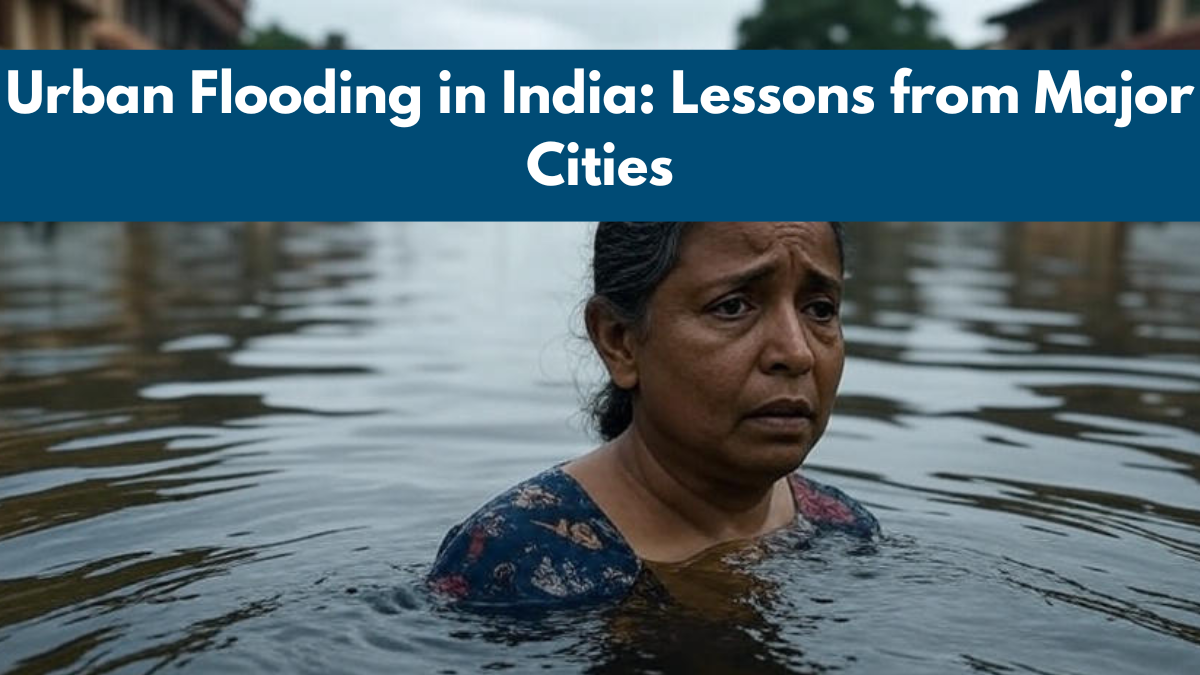Urban flooding India has become one of the country’s most pressing urban challenges. Rapid urbanization, shrinking wetlands, clogged drainage, and extreme weather events have combined to make floods a recurring nightmare in many cities. From Mumbai’s annual deluge to Chennai’s crippling floods, the crisis is no longer an exception but a predictable event. The need for stronger climate adaptation strategies is urgent if Indian cities are to survive the mounting risks of urban floods.

Causes of Urban Flooding in India
The root causes of urban flooding India are deeply linked to unplanned development. Natural drainage channels and wetlands have been encroached upon to make way for real estate. Simultaneously, outdated drainage systems are unable to cope with the intensity of modern rainfall. The issue is compounded by poor waste management that blocks stormwater flow.
Major contributors include:
- Encroachment on lakes, rivers, and wetlands
- Inadequate stormwater and sewage infrastructure
- Improper urban planning without flood-resilient designs
- Increased rainfall intensity due to climate change
This is where climate adaptation plays a role. Cities must plan not just for today’s rainfall but for future extreme weather patterns shaped by global warming.
Case Studies from Major Indian Cities
Several cities illustrate the magnitude of urban flooding India and the consequences of neglecting resilience:
- Mumbai: Experiences annual monsoon flooding due to clogged drains, low-lying geography, and unchecked construction.
- Chennai: The 2015 floods revealed the dangers of encroachment on lakes and insufficient drainage infrastructure.
- Bengaluru: Known for its disappearing lakes, it faces regular waterlogging due to rapid urban sprawl and poor waste disposal.
- Delhi: Faces flash floods as stormwater drains fail to cope with sudden cloudbursts, worsened by unregulated construction.
These examples show that without climate adaptation, India’s urban centers will continue to face severe economic and humanitarian losses.
Comparative Lessons from Global Cities
Cities across the world have tackled flooding through innovation and policy. A quick comparison highlights where urban flooding India stands and what it can learn:
| City (Global) | Strategy Adopted | Lessons for India |
|---|---|---|
| Rotterdam (Netherlands) | Water plazas and floating architecture | Design infrastructure to coexist with water |
| Tokyo (Japan) | Underground floodwater diversion tunnels | Build large-scale storage and drainage systems |
| Singapore | Integrated drainage and green spaces | Combine urban design with ecological solutions |
| Mumbai/Chennai | Reactive relief efforts | Shift to proactive climate adaptation plans |
This shows that while India often reacts after the disaster, global best practices emphasize prevention and integration of water management into city planning.
Strategies for Climate Adaptation
To address urban flooding India, the path forward must involve comprehensive climate adaptation strategies. Some key measures include:
- Restoring natural water bodies and wetlands to act as buffers
- Modernizing stormwater drainage with smart monitoring systems
- Promoting permeable pavements and green infrastructure
- Incorporating flood-resilience into urban planning codes
- Community awareness campaigns for preparedness and waste management
These steps not only reduce flood damage but also build long-term urban resilience.
Conclusion
Urban flooding India is not just an infrastructure failure—it is a wake-up call for sustainable urban planning. Without proactive measures, economic losses and human displacement will only worsen. Integrating climate adaptation into city planning ensures resilience, protects livelihoods, and transforms vulnerable cities into models of sustainability. The lessons are clear: India must prepare, adapt, and innovate to safeguard its urban future.
FAQs
What is urban flooding India?
It refers to flooding in Indian cities caused by poor drainage, encroachment, and heavy rainfall, often leading to waterlogging and infrastructure collapse.
Why is climate adaptation important for Indian cities?
Climate adaptation helps cities prepare for extreme weather events, ensuring resilience against the growing threat of floods.
Which Indian cities are most affected by urban flooding?
Mumbai, Chennai, Bengaluru, and Delhi are among the most severely affected cities.
How can infrastructure changes reduce urban flooding India?
By restoring wetlands, modernizing drainage, and using green infrastructure like permeable pavements and water plazas.
What role can communities play in flood prevention?
Communities can help by managing waste properly, avoiding encroachment, and supporting local climate adaptation initiatives.
Click here to learn more